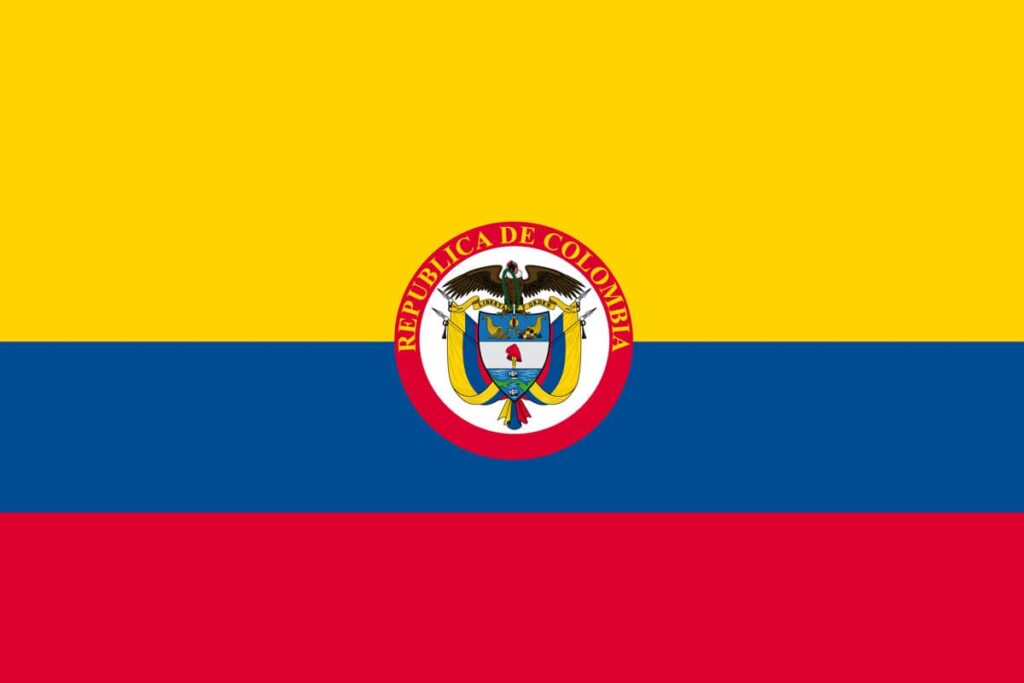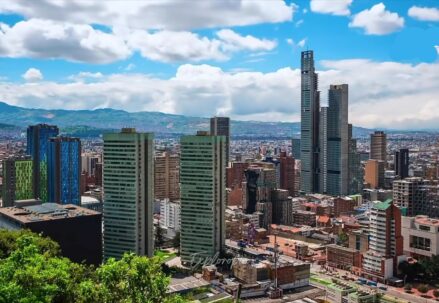In the heart of Colombia beats a rhythmic fusion that transcends borders and captivates souls – the pulsating rhythm of cumbia. Originating from the country’s Caribbean coast, cumbia embodies the spirit of Colombia’s multicultural heritage, blending indigenous, Hispanic, and African influences into a vibrant tapestry of sound and movement. From lively festivals to intimate gatherings, cumbia’s infectious beat brings people together, uniting them in a celebration of tradition, diversity, and community.
Colombian Flag: A Tapestry of History

The Colombian flag, with its vibrant hues of yellow, blue, and red, is more than just a piece of cloth fluttering in the wind. It is a tapestry woven with threads of history, resilience, and national identity.
Each color on the flag carries deep symbolism, reflecting the country’s storied past and aspirations for the future. The golden yellow, occupying half of the flag, represents the wealth of Colombia’s land, once abundant with precious metals like gold. It serves as a reminder of the nation’s rich natural resources and economic potential:
- The deep blue swathes symbolize Colombia’s two coastlines, bordered by the Caribbean Sea and the Pacific Ocean. These waters have long been integral to Colombia’s identity, serving as gateways for trade, exploration, and cultural exchange;
- The striking red, boldly emblazoned on the flag, is a poignant reminder of the sacrifices made by those who fought for Colombia’s independence. It represents the blood spilled by countless patriots who bravely resisted colonial rule and paved the way for a sovereign nation.
So, the next time you catch a glimpse of the Colombian flag fluttering majestically in the wind, take a moment to appreciate the profound symbolism woven into its fabric. It is not just a flag; it is a living testament to Colombia’s past, present, and future—a beacon of hope and inspiration for generations to come.
Melodies of Identity: The National Anthem
In Colombia, the National Anthem isn’t just a tune; it’s a symphony of pride, echoing the nation’s resilience and spirit.
- A Musical Tapestry. Composed in 1887 by one of Colombia’s presidents, the National Anthem weaves together notes of history and patriotism. Its stirring melodies evoke the struggles and triumphs of generations past, serving as a reminder of Colombia’s enduring spirit;
- Daily Rituals of Remembrance. Unlike in many other countries, where the National Anthem is reserved for special occasions, in Colombia, it’s a part of daily life. Broadcast on national television and radio at 6 a.m. and 6 p.m., it punctuates the rhythms of everyday existence, uniting Colombians in a shared sense of identity and purpose;
So, the next time you hear the strains of Colombia’s National Anthem, take a moment to listen – to really listen. For in those notes, you’ll hear the echoes of a nation’s soul, singing out proudly for all the world to hear.
Floral Splendor: Emblem of Diversity

In Colombia, the national flower, the May Flower, isn’t just a bloom; it’s a living symbol of the country’s extraordinary biodiversity and cultural heritage.
- Botanical Bounty. Colombia boasts an unparalleled wealth of flora, with over 4,000 species of orchids alone. Among this botanical bounty, the May Flower, scientifically known as the Cattleya trianae, stands out for its beauty and symbolism;
- A Tapestry of Colors. What makes the May Flower truly special is its vibrant hues, which mirror the colors of the Colombian flag. With its petals adorned in shades of yellow, blue, and red, the May Flower serves as a national emblem of Colombia’s national pride and identity;
- Cultural Significance. Named after the Colombian botanist José Jerónimo Triana, the May Flower was officially designated as the national flower over 80 years ago. Its selection was no accident; the flower’s unique coloration aligns perfectly with Colombia’s flag, making it a fitting symbol of the nation’s cultural and natural heritage.
For in its delicate petals, you’ll find a reflection of Colombia’s natural wonders and cultural treasures, blooming brightly for all to behold.
Reaching for the Sky: Wax Palm Majesty

In Colombia’s Cocora Valley, the majestic wax palm stands tall, a symbol of resilience, ecological significance, and cultural heritage.
- Tower of Strength. The wax palm, scientifically known as Ceroxylon quindiuense, holds the title of the world’s tallest palm tree, reaching staggering heights of up to 60 meters. Its slender trunk, crowned with a cluster of vibrant green fronds, casts a striking silhouette against the Colombian sky, symbolizing strength and endurance;
- Guardian of Tradition. For centuries, the wax palm has been intertwined with Colombian culture and tradition. Indigenous communities revered these towering giants as sacred symbols of life and fertility, while Spanish colonizers marveled at their beauty and utility. Today, the wax palm remains a cherished emblem of Colombia’s natural heritage, revered by locals and visitors alike;
Awe-Inspiring Encounters. For travelers to Colombia, a visit to the Cocora Valley offers a chance to witness the wax palm’s towering majesty firsthand. Trekking through mist-shrouded forests and verdant valleys, visitors can marvel at these ancient sentinels, standing sentinel against the passage of time. Whether framed against a backdrop of rolling hills or bathed in the golden light of sunrise, the wax palm serves as a reminder of Colombia’s natural wonders and the importance of preserving them for future generations.
Craftsmanship in Weave: Sombrero Vueltiao

In the heart of Colombia, the sombrero vueltiao stands as a testament to indigenous craftsmanship, cultural heritage, and artistic ingenuity.
- Weaving Tradition. Crafted by the Zenu indigenous people of Colombia’s Caribbean coast, the sombrero vueltiao is a marvel of traditional craftsmanship. Made from caña flecha, a type of cane native to the region, these iconic hats are woven with remarkable precision and skill, each strip carefully intertwined to create a distinctive pattern;
- Symbol of Identity. More than just a fashion accessory, the sombrero vueltiao holds deep cultural significance for the Zenu people and Colombia as a whole. Its circular shape represents unity and eternity, while its black and white color scheme symbolizes the balance between light and dark, good and evil. Wearing a sombrero vueltiao is not just a fashion statement; it’s a proud declaration of identity and heritage.
As Colombia’s cultural landscape continues to evolve, efforts are underway to preserve and promote the tradition of sombrero vueltiao weaving. Artisan cooperatives and cultural organizations are working to ensure that this ancient craft thrives in the modern world, providing economic opportunities for indigenous communities and keeping their cultural heritage alive for future generations.
Emeralds: Treasures from Colombian Soil

Nestled deep within Colombia’s soil lie treasures of exquisite beauty and profound cultural significance – emeralds, the jewels of the nation’s heart.
- Green Fire of the Earth. Colombia’s emerald mines have long been renowned as some of the most prolific in the world, yielding gemstones of unparalleled quality and allure. From the rugged terrain of Boyacá to the lush valleys of Cundinamarca, these verdant jewels are a testament to the geological wonders hidden beneath Colombia’s surface;
- A Legacy of Riches. For centuries, emeralds have been intertwined with Colombia’s history and culture, revered by indigenous peoples and coveted by conquistadors alike. The native Muisca people worshipped these precious stones as symbols of fertility and power, while Spanish colonizers saw them as symbols of wealth and prestige. Today, emeralds continue to hold a special place in Colombian culture, celebrated for their beauty and revered for their intrinsic value;
Among Colombia’s emerald treasures, none shines brighter than the legendary Gachalá Emerald. Discovered in the mountains of Boyacá in 1967, this extraordinary gemstone weighs a staggering 172 grams and measures over 5 centimeters in length. With its mesmerizing green hue and flawless clarity, the Gachalá Emerald is not just a gemstone; it’s a national treasure, a symbol of Colombia’s natural abundance and enduring allure;
Majestic Soar: Andean Condor’s Realm

In Colombia’s vast mountainous landscapes, the Andean Condor reigns supreme, embodying the spirit of freedom, resilience, and ecological harmony.
With a wingspan that can exceed three meters, the Andean Condor is one of the largest flying birds in the world, a true titan of the skies. Its majestic silhouette, soaring effortlessly on thermal currents, evokes a sense of awe and wonder, inspiring admiration and reverence among all who behold it;
For centuries, the Andean Condor has been revered as a symbol of power and majesty by indigenous cultures throughout the Andes. Known as “the ruler of the upper world,” it holds a sacred place in the hearts and minds of the Andean people, representing strength, wisdom, and spiritual connection to the natural world
Brew of Identity: Colombian Coffee
In every sip of Colombian coffee lies a tale of tradition, community, and unparalleled quality, brewing an identity as rich as its flavor.
- A Legacy of Excellence. Colombian coffee is renowned worldwide for its exceptional quality and distinctive flavor profile. From the fertile soils of the Andes to the misty slopes of the Sierra Nevada, Colombia’s coffee-growing regions produce beans prized for their rich aroma, balanced acidity, and smooth finish. For generations, coffee cultivation has been more than just a livelihood; it’s been a way of life, deeply ingrained in the cultural fabric of Colombia;
- Cultural Cornerstone. In Colombia, coffee isn’t just a beverage; it’s a cultural cornerstone, celebrated in rituals, traditions, and social gatherings. From morning cafecitos to afternoon tinto breaks, coffee serves as a catalyst for connection, conversation, and camaraderie. Whether enjoyed in bustling city cafes or remote mountain villages, the shared experience of savoring Colombian coffee fosters bonds that transcend social divides and unite people from all walks of life;
As one of the world’s largest coffee exporters, Colombia has earned a reputation as a global ambassador for quality coffee. Colombian beans are prized by connoisseurs and coffee aficionados alike, sought after for their exceptional taste and consistency. From specialty roasters in trendy urban hubs to multinational coffee chains in far-flung corners of the globe, Colombian coffee’s reach extends far beyond its borders, spreading the joy of a perfectly brewed cup to every corner of the world.
Games of Tradition: Tejo’s Legacy
Tejo, Colombia’s ancient game, weaves a tale of cultural heritage, camaraderie, and explosive fun, embodying a legacy that transcends generations.
- Ancient RootsTejo’s origins stretch back over five centuries, rooted in the traditions of Colombia’s indigenous peoples. Initially a ceremonial practice, it evolved into a beloved pastime, cherished for its blend of skill, strategy, and excitement. Today, Tejo stands as a testament to Colombia’s rich cultural tapestry and the enduring appeal of traditional sports;
- The Art of Tejo. At its essence, Tejo is a game of precision and power. Players take turns throwing metal discs, aiming to strike small targets filled with gunpowder. The resulting explosions are a thrilling testament to skill and accuracy, sparking cheers and celebrations among participants and spectators alike.
Tejo isn’t just a game; it’s a social institution, fostering connections and camaraderie across Colombia. Whether played in rural villages or urban centers, Tejo brings people together in a spirit of friendly competition and shared enjoyment. Amidst laughter and banter, friendships are forged, and bonds are strengthened, creating lasting memories and traditions.
Rhythmic Fusion: Cumbia’s Beat
Cumbia, a rhythmic fusion of indigenous, Hispanic, and African cultures, pulsates through Colombia’s soul, weaving tales of tradition, diversity, and celebration.
- Cultural Melting Pot. Originating from Colombia’s Caribbean coast, cumbia is a musical tapestry woven from diverse cultural threads. Its roots trace back to indigenous rhythms, Spanish melodies, and African beats, blending together to create a unique and vibrant sound that captures the essence of Colombia’s multicultural heritage;
- Infectious Rhythms. At the heart of cumbia lies its infectious rhythm – a hypnotic blend of drums, flutes, and maracas that beckons listeners to dance. With its pulsating beat and lively melodies, cumbia ignites celebrations, festivals, and gatherings across Colombia, infusing every moment with joy, energy, and a sense of community;
- National Dance. Recognized as Colombia’s national dance, cumbia holds a special place in the country’s cultural identity. From bustling city streets to remote rural villages, Colombians of all ages come together to move to the rhythm of cumbia, celebrating their heritage and embracing the spirit of unity and solidarity.
As Colombia’s cultural ambassador, cumbia celebrates the country’s rich diversity and multiculturalism, uniting people from different backgrounds in a shared appreciation for music, dance, and tradition. Through its vibrant rhythms and timeless melodies, cumbia embodies the spirit of Colombia, inviting everyone to join in the dance and embrace the joy of cultural fusion.
Conclusion
As our journey through Colombia’s musical landscape comes to an end, one thing is abundantly clear – cumbia isn’t just a genre of music; it’s a way of life, a celebration of heritage, and a testament to the power of rhythm to unite hearts and minds. From its humble origins on the Caribbean coast to its global influence on music and culture, Columbia’s legacy endures, weaving a thread of tradition and joy through the fabric of Colombian society.
As we bid farewell to the vibrant rhythms of cumbia, let us carry with us the spirit of celebration, diversity, and unity that it embodies, reminding us that music has the power to transcend boundaries and connect us all in a shared journey of discovery and delight.





